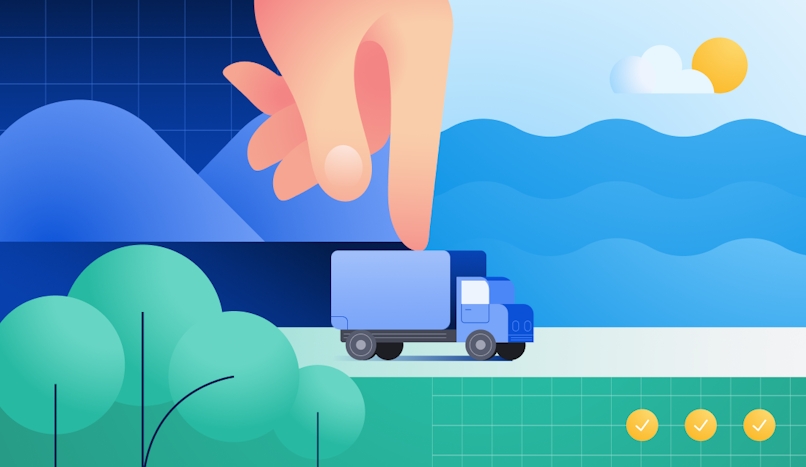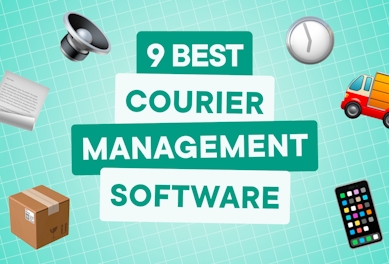35 Last-Mile Delivery Trends & Statistics for 2023
Discover the latest trends and statistics in last-mile delivery for 2023, including innovative technologies and market growth projections.

Want to stay ahead of the curve in last-mile delivery and optimize your team’s efficiency and productivity? Check out Circuit for Teams.
Key takeaways:
- Emerging technologies like robotics, automation, blockchain, and AI-powered routing are transforming last-mile delivery and making it more efficient and convenient.
- The global last-mile delivery market should grow at a CAGR of 20.6 percent between 2022 and 2030, reaching a value of $121.1 billion by 2030.
- Predictive analytics and AI-powered routing, blockchain and smart contracts, and robotics and automation should drive growth in the last-mile delivery market in the coming years.
If your business sells products online like Amazon or handles deliveries, you’re probably familiar with last-mile delivery.
It’s the final leg of the journey where a package goes from your warehouse or transportation hub to its final destination — like the customer’s home.
Customers are demanding faster and more convenient delivery options. As a result, businesses continue to invest in improving their last-mile delivery.
In fact, last-mile delivery is one of the most expensive parts of retail logistics, costing an average of $10 per package delivered.
This article presents some of the top last-mile delivery trends expected to shape the market in 2023. Many exciting developments are on the horizon — from drones to sustainable packaging solutions.
So, if you’re curious about the future of last-mile delivery, keep reading!
Emerging technologies in last-mile delivery
Last-mile delivery is evolving to meet increasing consumer expectations and optimize business operations. Here are some new technologies transforming the delivery of goods.
Robotics and automation
Robotics and automation are revolutionizing last-mile delivery, making it more efficient and convenient.
We surveyed 1,000 American consumers and delivery drivers about their thoughts on the future of AI driverless and drone deliveries. Thirty-nine percent believed such technology will make delivery faster, while 36 percent think the biggest benefit will be reduced road traffic.
Companies, such as Domino’s Pizza, are testing self-driving vehicles and autonomous vehicles to improve delivery times and lower operating costs. This technology also reduces reliance on human labor and boosts the customer experience.
- The autonomous last-mile delivery market should reach $4.96 billion by 2030.
- Starship Technologies is a key player in the autonomous delivery robots marketplace. It operates a team of 1,700 robots and records about 10,000 deliveries daily.
Blockchain and smart contracts
Sometimes, packages get delivered to the wrong address or get lost in transit, causing frustration for both customers and businesses.
The customer may then need to spend time on the phone with customer service trying to track it down. This results in a poor customer experience.
Blockchain and smart contracts are potential solutions for such challenges facing last-mile delivery.
They can improve transparency, security, and efficiency during the movement of products.
Businesses can accurately track the movement of goods using blockchain and smart contracts — reducing the risk of theft or errors during the delivery process.
Companies like Walmart, Nestle, and Unilever use this smart technology to accurately track their products at different stages of the supply chain.
- The global blockchain market should grow from $10.13 billion in 2022 to $17.21 billion in 2023, with a compound annual growth rate (CAGR) of 70 percent.
- A survey of logistics workers found that 82 percent work in companies that use blockchain. Moreover, 87.5 percent know of the benefits the technology can bring to their industry.
Predictive analytics and AI-powered routing
Data analytics and artificial intelligence are powerful tools for businesses. They can give insight into factors like customer behavior and traffic patterns that affect delivery times.
AI-powered algorithms can optimize delivery routes and identify issues before they happen — preventing delays and improving the customer experience.
By spending fewer hours on the road, drivers are also likely to face fewer health issues, such as lower back pain and lack of sleep, that come with the job.
This technology has varied applications and is highly scalable.
An example is food delivery apps like Uber, which use AI to deliver hot food. The Port of Montreal also uses AI to optimize the rapid distribution of essential goods like medical equipment.
- Ninety-five percent of shippers and 99 percent of third-party logistics (3PL) companies believe that analytics is necessary.
- The global AI-enabled last-mile delivery market will be worth $5 billion in revenue by 2035.
Market growth and projections
The demand for last-mile delivery solutions should increase in the coming years as businesses strive to enhance their delivery operations.
Suppose you own an organic grocery shop. Your customer needs groceries for the weekend but has a busy schedule and can’t make it to the store.
They decide to order online and select next-day delivery.
However, when the groceries arrive, some items are missing, and others are spoiled.
The customer contacts customer service, but they can’t offer a solution quickly.
Chances are, that customer won’t be shopping at your store again.
This highlights the importance of quick and reliable last-mile delivery services, particularly for time-sensitive products.
Global last-mile delivery market size and growth projections
The last-mile delivery market has many players, including traditional logistics services, eCommerce companies, and startups offering innovative solutions.
All stakeholders are on the lookout for new technologies, leading to consistent growth in the sector.
- The global last-mile delivery market size stood at $27.1 billion in 2022. It should grow at a CAGR of 20.6 percent between 2022 and 2030, reaching a value of $121.1 billion by 2030.
- The Asia Pacific autonomous last-mile delivery market should have a CAGR of 17.5 percent from 2021 to 2028. This growth is due to the thriving retail and eCommerce sectors and rapid economic growth.
Increasing demand for same- and two-day delivery
Modern customers expect quick and hassle-free delivery options — leading to the rising popularity of same- and two-day delivery.
Because of this, businesses are under pressure to have faster last-mile delivery services.
- The global same-day delivery services market rose from $6.44 billion in 2022 to $7.93 billion in 2023. It grew at a CAGR of 23.1 percent.
- There are many challenges to running same-day delivery at scale. They include real-time order visibility and tracking (51 percent) and the travel time between the delivery points (49 percent).
- Close to 60 percent of shoppers pay for faster delivery, with 69 percent paying more for next-day delivery.
Expansion of last-mile delivery services to new markets
As the last-mile delivery market grows, services are expanding to new regions. They also cater to new types of products and customers.
- The market for online, on-demand food delivery services should increase at a CAGR of 24.6 percent from 2022 to 2027.
- Last-mile logistics players prioritize grocery delivery due to the growing adoption and consistency in consumer buying patterns. Online grocery delivery should grow at a CAGR of 29 percent from 2020 to 2024.
- Mahindra Logistics has started a rural delivery project in 6,000 villages in India. It aims to strengthen the supply chain and supply last-mile delivery in rural areas.
Sustainability and environmental concerns

The effects of climate change are becoming more noticeable. As a result, businesses are turning toward eco-friendly practices.
Almost every market sector is witnessing a growing focus on sustainability. And the home delivery industry is no different.
Whether you’re a large eCommerce company looking to reduce your carbon footprint or a startup delivery business trying to stand out from competitors, offering eco-friendly delivery options can be the solution to your problems.
Importance of sustainable delivery practices
Sustainable delivery can be a game changer for delivery businesses. Using less fuel can help last-mile teams reduce greenhouse emissions and save on fuel costs.
- A study by the World Economic Forum found that using electric vehicles (EVs) can help last-mile delivery companies reduce CO2 emissions by 30 percent, the amount of energy used by 30 percent, and delivery costs by 25 percent.
Learn how EVs can help your delivery business become eco-friendly while saving you money. - Building a stronger network of order fulfillment centers can help lower last-mile emissions by 17 and 26 percent by 2025.
- Delivery giant UPS announced plans to have 50 percent fewer emissions from its global small package delivery business by 2035. Even the big players know it’s time for a change.
Impact of last-mile delivery on the environment and potential solutions
The last-mile delivery industry heavily relies on transportation, contributing to increased vehicles on the road and greenhouse emissions.
- Without intervention, last-mile delivery vehicles will produce 25 million tons of CO2 annually by 2030.
- Around 20 to 30 percent of a city’s total CO2 emissions come from last-mile delivery.
- Last-mile delivery vehicles make up around 27 percent of all vehicles on the streets in Hanoi, Vietnam. They’re responsible for nearly 13 percent of all emissions caused by vehicles in the city.
- McKinsey and the World Economic Forum came together to study the last-mile delivery landscape in Japan. They found that Japan will need 71 percent more delivery vehicles by 2030, causing a 25 percent increase in CO2 emissions.
Rise of eco-friendly delivery options
We’re seeing rising consumer demand for environment-conscious products and services. This is forcing delivery companies to explore more eco-friendly options.
As a result, more delivery businesses are turning toward electric vehicles.
Some popular green delivery options include:
- Full or partial EV-based teams that transport packages without burning carbon.
- More localized fulfillment networks where businesses build warehouses near areas with many customers.
- Using route optimization software to help delivery drivers spend less time on the road. Less time spent driving means less fuel consumption and faster deliveries.
Customer experience and expectations
ECommerce and the rise of small businesses have made the retail industry more competitive.
Customers now expect personalized customer experiences when they buy products or services.
The same goes for last-mile delivery.
Customers want timely and accurate delivery. They also expect real-time tracking and options like contactless delivery.
Consider the following scenario: Customer A orders a birthday gift for their friend and expects it to arrive on their friend’s birthday.
The package is delayed and doesn’t arrive on time, causing frustration for both the customer and the recipient.
Now, let’s look at another example. Customer B orders a new phone online and receives real-time tracking notifications about their order, including when it’s shipped and the expected delivery time.
Which customer do you think would recommend your business to their loved ones? The answer is pretty clear.
Importance of timely and accurate delivery
On-time delivery is the biggest customer expectation for delivery businesses.
If you want to keep your customers, give them a good delivery experience.
- Twenty-seven percent of customers in the United States expect to receive their online orders within a day of placing them.
- Sixty-five percent of customers said they would pay more for fast delivery.
Integration of real-time tracking and delivery notifications
Real-time tracking and regular notifications can promote customer satisfaction — making sure shoppers don’t have to wait for an order without knowing when it’ll arrive.
- Active order tracking compels customers to engage more with your business. Marketing emails are only opened ten to 20 percent of the time while tracking notifications are opened 50 to 80 percent of the time by customers.
- Sixty-nine percent of all customers list order tracking as one of their top three considerations for shopping with a brand.
Increasing demand for contactless delivery options
Initially caused by the pandemic, contactless deliveries are convenient and efficient — leading customers to recognize their benefits.
Customers prefer having special options like contactless delivery when placing orders online.
- One out of three customers said they would pay more for contactless services.
- Seventy-nine percent of customers in the US intend to increase their use of self-checkout and other contactless buying and delivery options.
Future of last-mile delivery

The surge in online retail has led to an increasing need for last-mile delivery services.
As more people shop online, there’s more demand for businesses to deliver their purchases.
Customers also expect greater convenience and personalized options in last-mile delivery services.
Predictions for the future of last-mile delivery
Here are some optimistic predictions for the last-mile delivery market:
- The global last-mile delivery market should cross $477 billion by 2030.
- Last-mile delivery will continue to account for 30 percent of all EV sales by 2025.
- The robotic delivery and automation market should rise by over 20 percent by 2026.
Potential challenges and opportunities for industry growth
Rising CO2 emissions and traffic congestion are big challenges for last-mile delivery services.
- The demand for last-mile delivery should increase substantially — around 78 percent by 2030. Keeping up with this demand while managing the ecological impact on the environment could be challenging.
- By 2023, the traffic congestion caused by last-mile delivery vehicles in the world’s top 100 cities should increase 36 percent.
Managing your own team? Find out why top-performing companies use Circuit for Teams
The future of the last-mile delivery market is largely positive. While demand and sustainability issues exist, businesses are adopting sustainable measures like EV teams and delivery route optimization systems.
At Circuit, we’re proud to be a part of the change.
Circuit for Teams helps delivery businesses like yours streamline their routes. This helps your drivers spend less time on the road and reduce fuel expenses.
Our platform now features highly intelligent automation and tracking features that can help you deliver faster and cater to your customers’ needs better.
Circuit for Teams offers route optimization, delivery driver tracking, optional proof of delivery, and satellite views of all delivery routes.
All these features help delivery businesses track each order closely, improve customer experience, and reduce delivery times.




